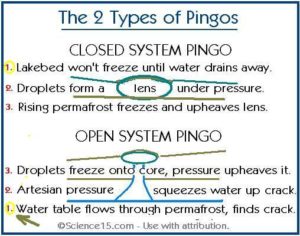
To know a pingo is to know a geologic and atmospheric event.
How pingos form and collapse can differ according to their location (i.e., whether on a slope or on flat land), and temperature changes to which they are exposed. Once the processes are known, one can extrapolate probable qualities of present or past geologic and atmospheric conditions, and predict future trends.
Every pingo forms around a growing, lens-shaped, ice core.
A pingo’s ice core is formed by one of two extremely gradual processes which may increase the size of the pingo by as little as 2 centimeters per year up to 200 feet in height, so that larger pingos are known to be many thousands of years old.
The ice core is formed of pure water. Therefore, methane, a byproduct of decaying organic matter contained in permafrost, is not a factor in pingo formation.
On flat, continuous permafrost, pingos form from the top down (closed system, by hydrostatic pressure).
Generally, on flat land, a pingo will be circular.
The explanation below explains that a tundra pingo requires a drained lakebed depression in which to start, and those necessary, pre-existing lakes are formed from melted ice wedges. Lakes will drain away. To see a video of this process, click here and scroll down to the video.
When soils cool and freeze in the winter, they contract, forming contraction cracks. During the spring snow-melt season, water pools in these cracks. In the winter, this water freezes into a thin wedge of ice. In the summer, small wedges of ice remain in the permafrost. In the winter, contraction cracks again form in the cycle. This creates solid ice wedges that grow, year by year.
If the ground above the wedge is disturbed and the ice is exposed, it may begin to melt away, causing the ground to sink into the void and create a pond, which is referred to as a “thermokarst lake.”
If the lake drains away, it leaves sand that is saturated. The very wet sand is squeezed under pressure by the surrounding freezing process and ultimately pushed upward, where it pools under the root mat and freezes. This large ice mass pushes up on the soil above it, creating the distinctive “pingo” hills that dot the Arctic tundra.
Source: How Pingos Form.
On sloping, discontinuous permafrost, pingos generally form from the bottom up (open system, by hydraulic pressure).
On a slope, a pingo’s shape will be altered by the slope, and a collapsed pingo may be associated with permafrost landslides.
Pingos can also form when artesian groundwater is forced up through cracks in the permafrost, pooling and freezing in a similar manner [to the closed system pingo].
Source: How Pingos Form.
Both pingo formation processes are considered similar to ice heaving.
Source: Coolgeography.co.uk provides diagrams of the two types of pingos.
Source: Also see Don Easterbrook’s guest essay on pingo formation at this link sparked a lively discussion in 2014, in connection with the new Siberian craters.
To see the permafrost foundation that determines the fate of a pingo, visit the next page.



